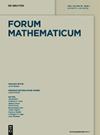On the largest prime factor of non-zero Fourier coefficients of Hecke eigenforms
IF 1
3区 数学
Q1 MATHEMATICS
引用次数: 0
Abstract
Abstract Let τ denote the Ramanujan tau function. One is interested in possible prime values of τ function. Since τ is multiplicative and τ ( n ) {\tau(n)} is odd if and only if n is an odd square, we only need to consider τ ( p 2 n ) {\tau(p^{2n})} for primes p and natural numbers n ≥ 1 {n\geq 1} . This is a rather delicate question. In this direction, we show that for any ϵ > 0 {\epsilon>0} and integer n ≥ 1 {n\geq 1} , the largest prime factor of τ ( p 2 n ) {\tau(p^{2n})} , denoted by P ( τ ( p 2 n ) ) {P(\tau(p^{2n}))} , satisfies P ( τ ( p 2 n ) ) > ( log p ) 1 8 ( log log p ) 3 8 - ϵ P(\tau(p^{2n}))>(\log p)^{\frac{1}{8}}(\log\log p)^{\frac{3}{8}-\epsilon} for almost all primes p. This improves a recent work of Bennett, Gherga, Patel and Siksek. Our results are also valid for any non-CM normalized Hecke eigenforms with integer Fourier coefficients.关于赫克特征型的非零傅立叶系数的最大素数因子
设τ表示Ramanujanτ函数。人们对τ函数的可能素数感兴趣。由于τ是乘性的,并且τ(n){\tau(n)}是奇的当且仅当n是奇平方,因此我们只需要考虑素数p和自然数n≥1的τ(p2 n){\tau(p^{2n})}。这是一个相当微妙的问题。在这个方向上,我们证明了对于任何ε>0{ε>0}和整数n≥1{n\geq 1},τ(p2 n){\tau(p^{2n})}的最大素因子,表示为p(τ(p2 n)){p(\tau(p ^{2n}))},满足p(τ p)1 8(日志 日志 p)3 8-εp(\tau(p^{2n}))>(\log p)^{\frac{1}{8}}{8}-\ε},这改进了Bennett、Gherga、Patel和Siksek最近的一项工作。我们的结果也适用于任何具有整数傅立叶系数的非CM归一化Hecke本征形式。
本文章由计算机程序翻译,如有差异,请以英文原文为准。
求助全文
约1分钟内获得全文
求助全文
来源期刊

Forum Mathematicum
数学-数学
CiteScore
1.60
自引率
0.00%
发文量
78
审稿时长
6-12 weeks
期刊介绍:
Forum Mathematicum is a general mathematics journal, which is devoted to the publication of research articles in all fields of pure and applied mathematics, including mathematical physics. Forum Mathematicum belongs to the top 50 journals in pure and applied mathematics, as measured by citation impact.
 求助内容:
求助内容: 应助结果提醒方式:
应助结果提醒方式:


